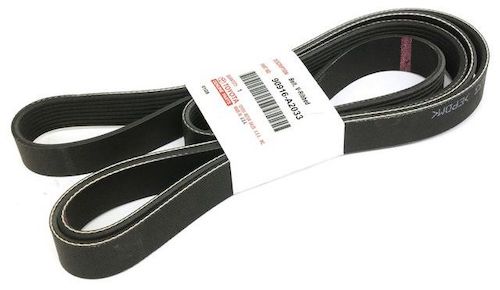Have you noticed your serpentine belt is worn out or damaged? Or maybe you're simply curious about its role in your vehicle's performance? No matter your reason, this comprehensive buyer’s guide is designed to help. Whether you’re looking to understand what a serpentine belt is, how to spot issues with it, or how to choose between OEM and aftermarket options, we’ve got you covered. Here’s what this guide will cover: Still have lingering questions? Feel free to reach out to us for further assistance! Take a quick peek at the side of your engine, and you’ll notice a sleek, winding belt threading through various pulleys. That’s the serpentine belt—essentially the lifeblood of your engine’s auxiliary systems. Composed of durable rubber, it powers essential components such as: Though seemingly simple, the serpentine belt plays a critical role. Without it, these vital systems would cease to function, leading to potential engine overheating, loss of steering control, and even complete engine failure. For a deeper dive into the mechanics of serpentine belts, check out our dedicated blog post. If you suspect your serpentine belt is nearing the end of its lifespan, prompt diagnosis is key. Fortunately, identifying issues with your belt is straightforward. Begin by performing a thorough visual inspection for telltale signs of wear or damage. These include: Early detection can prevent costly repairs down the road. Trust us—addressing these issues promptly is worth the effort! Replacing your serpentine belt might sound intimidating, but it’s actually a manageable task for most vehicle owners. By following this step-by-step guide, you can save significantly on labor costs while ensuring your car runs smoothly. The entire process involves loosening the tensioner pulley, carefully removing the old belt, and installing the new one. With some basic tools and a bit of patience, you’ll be good to go in no time.
For those who prefer visuals, here’s a handy video tutorial that walks you through each step in detail: When shopping for a replacement serpentine belt, you’ll encounter two primary options: OEM (Original Equipment Manufacturer) belts and aftermarket alternatives. While both serve the same purpose, there are notable differences in quality and performance. Our detailed comparison guide reveals why OEM belts consistently outperform aftermarket counterparts in terms of: For a comprehensive breakdown of why OEM belts reign supreme, head over to our full-length guide. Rest assured, choosing the right belt can make all the difference in maintaining your vehicle’s peak performance. Need more advice on vehicle maintenance? Explore our other resources for expert tips and insights! Thank you for reading! We hope this guide has provided clarity and confidence in managing your serpentine belt needs. Safe travels! DSG03-3C2 Series Direction Valves Dsg03-3C2 Series Direction Valves,Magnetic Exchange Valve,Solenoid Controlled Hydraulic Valves,Solenoid Actuated Directional Control Valve Shanghai Jinhai Hydraulic Co.,Ltd , https://www.shanghaijinhai.com
Unpacking the Role and Significance of a Serpentine Belt
Identifying a Faulty Serpentine Belt: Signs and Symptoms
Replacing Your Serpentine Belt: A Simple DIY Tutorial
OEM vs. Aftermarket Serpentine Belts: Which Should You Choose?

Toyota Serpentine Belt Buyer's Guide